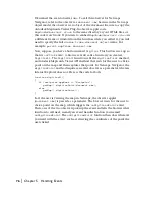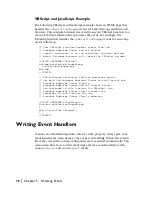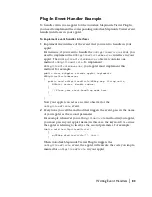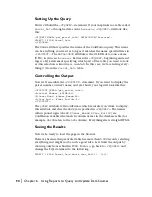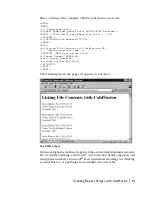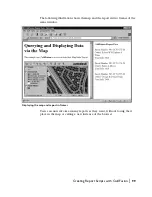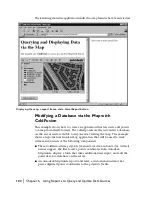
Creating Report Scripts with ColdFusion
|
89
Creating Report Scripts with ColdFusion
A ColdFusion script, or
template
, is essentially a standard HTML file that
includes extra tags written in a server-side markup language called CFML
(ColdFusion Markup Language). CFML tags begin with the letters
CF
, and are
used to tell ColdFusion to process either a calculation or a query. The tags can
also tell ColdFusion which data source you want to use and how you want to
manipulate or display the information in that data source. A template uses
the file extension
.cfm
to identify itself and let the Web server know that it
should be passed to the ColdFusion service for processing.
ColdFusion was designed to provide database connectivity to your Web
pages. It is a full-fledged development environment that includes functions,
operators, variables, control structures, and more. You can use ColdFusion to
create powerful and complex Web applications. But simple applications have
their uses too, as we’ll see later in this chapter. Despite its power, ColdFusion
is fairly easy to learn; if you’re familiar with HTML coding, you’ll get up to
speed quickly.
The following examples show how to create report scripts with ColdFusion.
We recommend that you read them in order.
Note
For ASP versions of the same examples, see “Creating Report Scripts with
ASP” on page 109.
Listing File Contents with ColdFusion
This example shows a simple template that lists the contents of a map
resource database. Note that this template accesses the database directly,
instead of using the Autodesk MapGuide reporting feature. Later, we’ll see
how Autodesk MapGuide fits into the picture.
Let’s say you have an MWF file that points to a database containing parcel
information, such as the lot number, street address, owner’s name, and so
on. If you want to list the contents of that database at the bottom of an
HTML page displaying the map, you would first rename the HTML file with
a
.cfm
extension and place it in a directory with script or execute permissions.
Then you would add
<CFQUERY>
and
<CFOUTPUT>
statements to the file. The
<CFQUERY>
tag tells ColdFusion which database to use and which records to
select from that database. You can place
<CFQUERY>
anywhere in the page,
as long as it appears before
<CFOUTPUT>
. The
<CFOUTPUT>
tag controls how
the database output will be displayed on the page. You place this tag within
<BODY>
, at the location you want the database output to appear.
The next sections describe each of these tasks in more detail.
Содержание 15606-011408-9300 - MAP R6.3 UPG
Страница 1: ...15306 010000 5060 October 2001 Autodesk MapGuide Release 6 Developer s Guide ...
Страница 6: ...vi ...
Страница 16: ...16 ...
Страница 30: ...30 ...
Страница 84: ...84 ...
Страница 134: ...134 ...
Страница 202: ...202 ...


